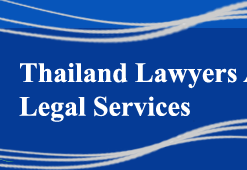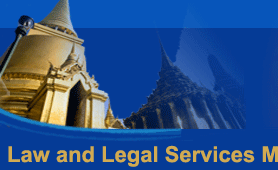



    |
|
|
|
|
II. REQUIREMENTS FOR PATENTABILITY IN THAILAND
A. Novelty
Like patent legislations in other countries, the Patent Act provides that an invention seeking legal protection in Thailand must be new. An invention is considered new if it does not form part of the state of the art.28 According to s.6 para.2, as amended, the state of the art "includes any of the following inventions:
(1) an invention which was widely known or used by others in the country before the data of the application for a patent ;
(2) an invention the subject matter of which was described in a document or printed publication, displayed or otherwise disclosed to the public, in this or a foreign country before the date of the application for a patent ;
(3) an invention which was patented in this or a foreign country before the date of application for a patent ;
(4) an invention for which a patent was applied in a foreign country more than twelve months before the date of the application for patent and a patent has not been granted for such invention ;
(5) an invention for which a patent was applied for in this country, but the applicant had abandoned such application. This provision shall not affect the rights of the joint inventor and other persons who did not jointly apply for a patent."
It is clear from s.6(2) that the scope for examination of prior disclosure in publication is determined on an international perspective, which creates a problem of worldwide examination to Thailand which is still far from the level of high technology, and does not have sufficient resources to apply the standard of worldwide novelty. However, the definition of the state of the art in s.6(1) seems to show that Thailand's law has rejected the "absolute novelty" test used in many European countries, as only an invention which was widely known or used in a domestic area before the filing date will preclude granting of a patent.
But the law is ambiguous, as s.6(2) does not correspond with the language used in s.6(1). While s.6(1) limits the disclosure in such a manner that the invention was widely known or used by others in Thailand only, s.6(2) states ambiguously that the state of the art includes "an invention the subject matter of which was… displayed or otherwise disclosed to the public, in this or a foreign country."
The law's vagueness may cause a lot of confusion in interpretation, since an invention can be publicly displayed or disclosed in many ways, e.g.in writing oral form, or by being open to public inspection. For example, if the inventor disclosed the details of his invention in another country by giving a public lecture before filing an application in Thailand : does this make the invention lack novelty under Thai law? This is quite unclear. Even though such oral disclosure does not make the invention widely known or, indeed, used in Thailand under s.6(1), it may be considered that the invention has already been disclosed to the public in a foreign country before the application for a Thai patent, in which case the novelty of such an invention will be lost under s.6(2).
This provision seems to be similar to the novelty definition under US patent law, which reaquires that a patentable invention should not be known or used in a domestic area, and should not be described in a buplication anywhere in the world. The rationale behind this is to limit the difficulty of the examination of public disclosure outside the country.29 Unlike the Thai law, the US Patent Act is much clearer, as it does not take into account public availability in a foreign area by ways of display or disclosure for consideration of novelty.30
According to s.6(4), where an invention has been applied for a patent, for not more than twelve months, in a foreign country, such an invention is still new in the eyes of the Patent Act. This reflects the ambition of the Thai legislature to conform to the Paris Convention by adopting the "right of priority" principle into the Patent Act.31 But an invention which may qualify for legal protection must not have been patented before. If a patent was granted to such an invention in Thailand or in another country, the invention will be barred from patentability, according to s.6(3).
Under the old s.6(5), where an inventor filed a patent application in Thailand and subsequently abandoned his application, nobody, except the joint inventor who did not jointly apply for a patent, would be entitled to obtain a patent on such an invention. This may cause a problem to a true inventor if someone had learned of, or unlawfully obtained, an invention from an inventor and then filed a patent application before the true inventor. This person no doubt could not obtain a patent, as he was not an inventor as required by s.10.However, if the application was subsequently abandoned by such a person, the abandonment of the application may preclude the right of the true inventor to apply for a patent.32
The solution to this problem, whether an application filed by a person other than the inventor should be regarded as an application for the purpose of s.6(5), was left to judicial interpretation. In order to remove this difficulty, s.6(5) as amended states that the abandonment of the application "shall not affect the rights of both the joint inventor and other persons who did not jointly apply for a patent."
Thailand's patent law also constitutes a non-prejudicial disclosure provision, as do many others countries. The Patent Act does not regard three particular circumstances of public disclosure as forming part of the prior art.33 These are : (I) when a disclosure is the result of the subject matter having been uniawfully obtained; (ii) when a disclosure is the result of displaying the invention at an international exhibition or an official exhibition ; and (iii) when the subject matter of the invention was disclosed by the inventor himself. In these three cases, the inventor must file a patent application within twelve months from the date of disclosure, in order to preserve his right.
The amended s.6 para.3 has introduced a period of grace for an inventor who previously disclosed his invention by any means to obtain legal protection. The grace period will enable the inventor to evaluate the economic value of his invention before applying for a patent, and allows the filing of an invention that has been accidentally disclosed.34
This would foster inventors to bring inventions into public arena through the patent system.
The new law does allow the inventor to disclose his invention before filing an application. But the inventor has to take a further step by filing his application within twelve months of the disclosure. The amended s.6 para.3 recognises extension of the period of grace with regard to which the inventor must file an application from 180 days under the old provision to twelve months. Who cannot finish his inventive activity in the specified time.
The Patent Act does not make provisions relating to the concepts of enabling disclosure, whole-contents, the post-infringement test, selection patents, and the new use of an old invention. The practical approach of these rules is, therefore, dependent upon interpretations of the patent examiners and the courts.
28 Ibid, s.6.
29 Wegner, op.cit.,at p.79.
30 See US Patent Act, s.102.
31 Patent Act B.E. 2522, amended by Patent Act B.E. 2535.s19 A.
32 See Oyen, G.O.S., The Canadian Patent Law Amendments of 1987, Intellectual Property Journal, Vol.4,1988,p.250.
33 Patent Act B.E.2522,amended by Patent Act B.E.2535, s.6 para.3.
34 See Wegner, op.cit, at pp.88-97